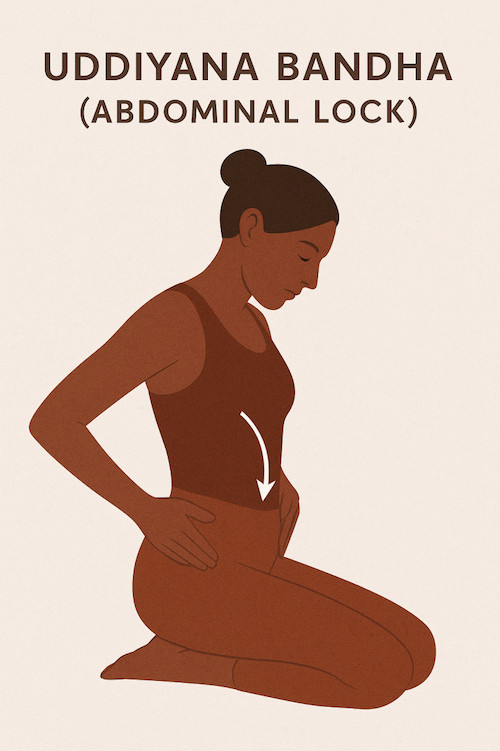
Uddiyana Bandha is a yogic abdominal lock performed after full exhalation to draw the abdomen inward and upward, stimulating the upward flow of pranic energy through the central energy channel, Sushumna Nadi. It is a key practice in Hatha Yoga, used to activate core muscles, support digestion, and direct subtle energy for higher yogic work.
The Sanskrit word Uddiyana means “to rise” or “fly upward,” and Bandha means “lock” or “seal.” This technique creates a vacuum effect in the chest, which lifts energy from the lower abdomen and helps awaken the body’s inner energetic system. It plays an essential role in cleansing kriyas like Nauli, Basti, and Vajroli Mudra.
The Hatha Yoga Pradipika highlights its significance:
“It is the lion that conquers the elephant, death. Of all the bandhas, Uddiyana is the best. Once it is mastered, liberation occurs spontaneously.”
— Hatha Yoga Pradipika, Chapter 3, Verse 57
Regular practice of Uddiyana Bandha strengthens the diaphragm and abdominal region, improves digestive fire (agni), and prepares the body for advanced practices such as pranayama, dhyana, and kundalini awakening.
How to do uddiyana bandha(abdominal lock)
Uddiyana Bandha is performed after a full exhalation, by drawing the abdomen inward and lifting it upward toward the ribcage. This yogic lock is best practised on an empty stomach, ideally in the morning, when the abdominal region is light and the breath is calm.
Preparation
Before starting, choose one of the two basic positions:
Standing Position (Recommended for Beginners)
- Stand with feet shoulder-width apart and keep the spine straight.
- Slightly bend your knees.
- Lean forward gently and place your palms on your thighs, just above the knees.
- Relax your shoulders and take a few deep breaths to settle your focus.
Sitting Position
- Sit comfortably in a meditative pose such as Padmasana or Siddhasana.
- Keep your back upright and place your palms on your thighs near the knees.
- Take a few deep breaths to relax the body and calm the breath.
Steps to perform uddiyana bandha

- Exhale completely through the nose or mouth until the lungs feel empty.
- Hold the breath out (external breath retention or bahya kumbhaka).
- Draw the abdomen inward, pulling the navel toward the spine.
- Lift the abdominal wall upward, creating a hollow space under the ribcage.
- Hold this position for a few seconds (as long as comfortable, without strain).
- Release gently, relax the abdomen, and slowly inhale to come out of the lock.
Note for Beginners:
If it’s difficult to lift the abdomen, try a mock inhalation expand your chest as if breathing in, without actually taking in air, while keeping your mouth and nose closed. This helps create the upward suction naturally.
When to practise uddiyana bandha
- Practice in the early morning, on an empty stomach.
- Avoid practice after meals or intense physical activity.
- The standing position is easier for beginners, as it offers better control of the abdominal muscles.
Common mistakes and tips
If you’re struggling with the technique, here are a few things to check:
- Not Exhaling Fully: Incomplete exhalation prevents the abdomen from lifting properly. Make sure to empty the lungs completely before applying the lock.
- Losing Focus: Uddiyana Bandha requires full attention on the abdominal region. Even a brief distraction can break the engagement. Practise in a quiet environment.
- Inhaling by Mistake: Do not let any air enter during the lock. Even a small breath during bahya kumbhaka will disrupt the vacuum and reduce effectiveness.
- Over-Tensing the Muscles: Avoid tightening the abdomen too hard. The lift should be firm but smooth. Over-effort can lead to strain.
Contraindication & Precautions
To practise Uddiyana Bandha safely and gain its full benefits, it’s important to follow these precautions.
- If you have high blood pressure, avoid practising Uddiyana Bandha, as it can cause a rapid increase in blood pressure.
- People with ulcers or hernia should also avoid this technique, as the abdominal pressure may worsen their condition.
- Pregnant women must not practise Uddiyana Bandha, as it may negatively affect both the mother and the unborn child.
- Avoid the practice during menstruation, as it can disrupt the natural downward flow of energy.
- Always practise on an empty stomach. Doing it after a meal may lead to stomach pain or indigestion.
- Do not push your body beyond its limit. If you feel discomfort or strain, gently release the lock. Overexertion can be harmful.
Uddiyana bandha(abdominal lock) benefits
Uddiyana Bandha engages the abdominal muscles and diaphragm, creating a powerful internal massage that improves physical strength, digestive function, and energy flow. Below are the key benefits of this yogic abdominal lock:
- Strengthens the Abdominal Region: Uddiyana Bandha acts as a natural workout for the abdominal muscles and diaphragm. It tones and strengthens the core, supports spinal health, and improves the movement of the diaphragm. This internal lock also massages the heart and lungs, enhancing their function and promoting overall vitality.
- Improves Digestion and Detoxification: The abdominal lift stimulates digestive fire (agni), which helps break down food efficiently and promotes the elimination of toxins from the body. With regular practice, it supports better metabolism and clears digestive sluggishness.
- Boosts Blood Circulation and Promotes Youthfulness: Uddiyana Bandha improves blood flow to the abdominal organs, brain, and heart. This enhanced circulation refreshes the nervous system, promotes mental clarity, and contributes to a feeling of lightness and youth.
- Balances the Vital Energies (Vayus): This practice reverses the downward flow of Apana Vayu (lower energy) and unites it with Prana Vayu (energy of the heart) and Samana Vayu (energy of digestion). This convergence of energies takes place in the region of the solar plexus (celiac plexus), activating the Manipura Chakra—the body’s energy and transformation centre. It enhances the function of all organs linked to this chakra and clears the path for inner awakening.
- Supports Kundalini Awakening: When combined with Moola Bandha, Uddiyana Bandha stimulates kundalini energy and channels it upward, helping to awaken the Anahata Chakra (heart centre). According to the Gheranda Samhita, this practice increases internal awareness and prepares the mind for dharana (concentration), dhyana (meditation), and ultimately, samadhi (absorption).
Conclusion
Uddiyana Bandha is a powerful yogic technique that strengthens the core, improves digestion, and activates the flow of pranic energy. By lifting the abdominal muscles after exhalation, it stimulates internal organs, purifies the energy channels, and prepares the body for deeper yogic practices. Rooted in classical Hatha Yoga texts, it is known for its ability to rejuvenate the body and awaken inner awareness. When practised with proper guidance and awareness, Uddiyana Bandha becomes a vital step toward physical vitality, mental clarity, and spiritual awakening.
FAQs
1. Is Uddiyana Bandha safe for beginners?
Yes, but it should be learned under guidance. Beginners should start in a standing position and avoid overexerting the abdomen.
2. Can Uddiyana Bandha reduce belly fat?
It tones the abdominal muscles and improves digestion, which may help reduce belly fat when combined with a healthy lifestyle.
3. How long should I hold Uddiyana Bandha?
Start with 5–10 seconds and gradually increase to 30 seconds, depending on your breath-holding comfort.
4. Can I do Uddiyana Bandha daily?
Yes, it can be practised daily on an empty stomach, preferably in the morning.
5. Does Uddiyana Bandha help with constipation?
Yes, it stimulates digestive organs and helps regulate bowel movements by improving digestive fire.
6. Is Uddiyana Bandha good for mental clarity?
Yes, it increases oxygen supply to the brain and balances energy flow, which enhances mental focus and clarity.
7. Can women practise Uddiyana Bandha?
Yes, but not during menstruation or pregnancy. Always consult a yoga expert for individual guidance.
8. What is the difference between Uddiyana Bandha and Nauli?
Uddiyana Bandha involves lifting the abdomen inward and upward, while Nauli is a dynamic movement of abdominal muscles using Uddiyana as a base.
9. Do I need to practise other bandhas with Uddiyana?
Advanced practitioners often combine Uddiyana with Mula Bandha and Jalandhara Bandha, but it’s not required for beginners.
10. What should I feel during Uddiyana Bandha?
You may feel a hollow under the ribcage, a lift in the abdomen, and a gentle upward flow of energy. There should be no pain or strain.

